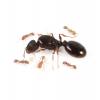I currently have a Lasius umbratus queen and recently captured a few Lasisus neoniger workers. I would appreciate any advice on how to best introduce Lasius neoniger workers to a Lasius umbratus queen. I recently tried to cool several Lasius neoniger workers and a Lasius umbratus queen in the same formicarium for one hour. After removing the formicarium, however, I found a Lasius neoniger worker attached to a leg of the Lasius umbratus queen (with its jaws). One individual suggested that I cool the Lasius neoniger workers for one week and then try introducing the Lasius umbratus queen to the colony. If I use this suggestion, should I also hibernate the Lasius umbratus queen? I would appreciate any advice. Thank you!
- Formiculture.com
- Forums
- Gallery
- Members
- Member Map
- Chat




















![UA's Lasius latipes [Discontinued] - last post by UtahAnts](https://www.formiculture.com/uploads/profile/photo-thumb-5683.jpg?_r=1633467752)


